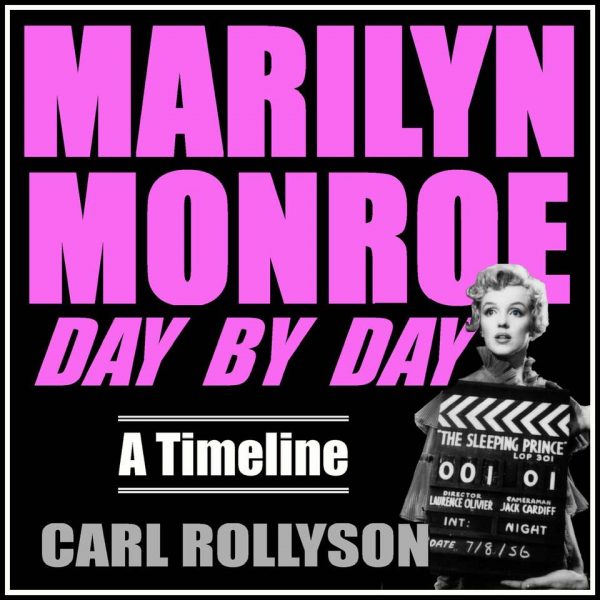
Carl Rollyson’s 2015 book, Marilyn Monroe: Day By Day, is now available on Audible (narrated by Joe Farmichella.)
Marilyn Monroe 1926-1962

Carl Rollyson’s 2015 book, Marilyn Monroe: Day By Day, is now available on Audible (narrated by Joe Farmichella.)
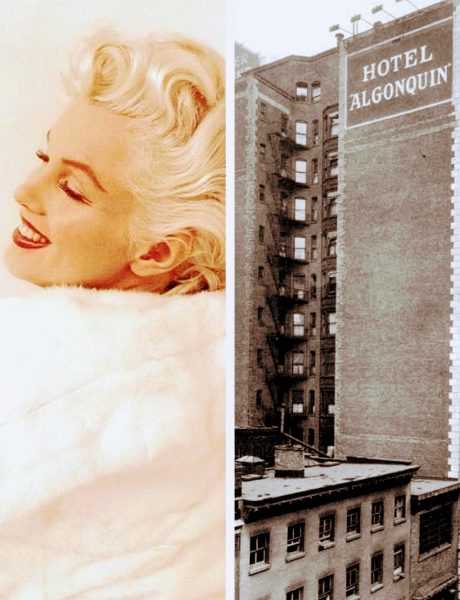
Michael Colby is a songwriter and the grandson of Ben and Mary Bodne, who owned Manhattan’s famed Algonquin Hotel from 1946-1987. In an interview with the New York Post‘s Barbara Hoffman, Colby recounts a somewhat risque tale of Marilyn.
“‘Marilyn Monroe used to come in at lunchtime and get a Beefeater martini,’ says Michael Colby, striding past the bar in the Algonquin Hotel on West 44th Street. And it was just down the street, at Fifth Avenue, that his grandmother once spotted her wearing a white mink coat.
‘If you think that’s something,’ the actress told her, perhaps after a few too many martinis, ‘you should see what’s underneath!’
Yes, Colby tells the Post, leaning against a portrait of hotel regular Tallulah Bankhead: His granny got flashed by Monroe.”
As fans will know, Marilyn was proud of her body, often went out sans underwear and thought nothing of wandering round her apartment or dressing room nude. Sam Shaw and Yves Montand have also told of similar encounters; but tales of Marilyn have a way of growing so that practically anyone vaguely connected to her will claim to have experienced the same.
Monroe biographer Carl Rollyson considers it ‘possible’, but points out that the Algonquin was not known as one of Marilyn’s more regular haunts, and that particular brand of exhibitionism was more commonly associated with the outrageous Tallulah Bankhead.

Many people – mostly men – have credited themselves with ‘discovering’ Marilyn. Among them, photographer David Conover – who found the teenage Norma Jeane working at the Radioplane munitions plant in 1945, and guided her through the first steps of her modelling career – is one of a select few who can rightfully claim to have played an essential role in her path to fame, as Carl Rollyson (author of Marilyn Monroe: A Life of the Actress) commented yesterday.
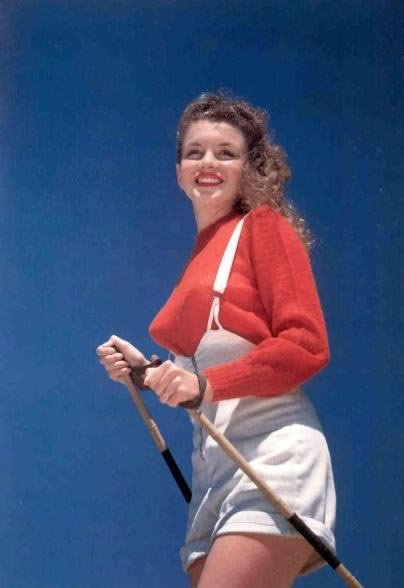
“I’ve always thought that Conover was the key figure in the transformation of Norma Jeane into Marilyn. I think he was the first professional photographer, professional anything, to tell her she had a future as a model and actress. I think he unlocked something in her that had been waiting to be released. I know from my own experience that it takes only one person to say with authority that you are something special. No matter what happens afterwards, no matter how hard it gets, that one person has liberated a spirit that cannot be suppressed.”
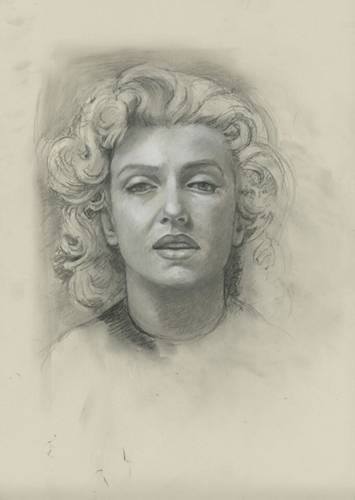
Heroines, an exhibition by artist Audrey Flack, will be on display at the Butler Institute of American Art in Youngstown, Ohio, from February 14-May 10, and includes a portrait of Marilyn among a range of female icons from Medusa to Mother Teresa.

Marilyn has been a recurring subject in Flack’s long career. One of her early ‘photorealist’ paintings of Marilyn graced the first edition cover of Carl Rollyson’s Marilyn Monroe: A Life of the Actress. By contrast, the Heroines portrait – inspired by Marilyn’s 1953 photo session with Ben Ross, and first seen in 2011 – is moody and bleak.
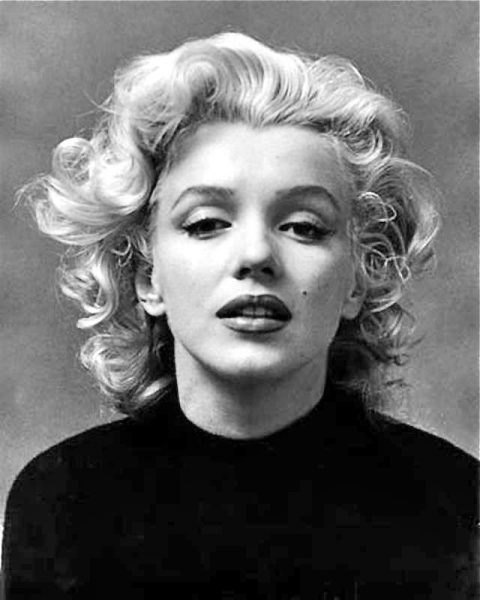
‘Flack’s drawing of Marilyn Monroe conveys a sad version of the sex symbol as a 30-something dependent on drugs and alcohol, lost and faded,’ Rebecca S. Nieminen writes in The Vindicator. ‘Unlike glossy, glamorous renditions of the late movie star, Flack’s depiction of Monroe requests sympathy. ‘
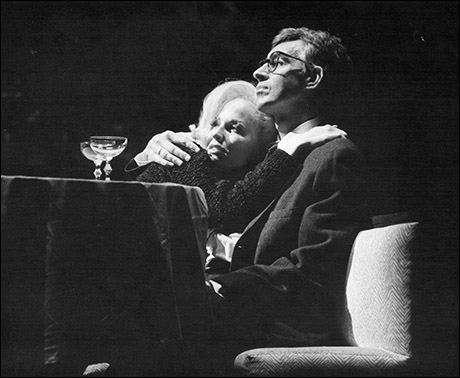
I’ve said before that there are so many plays about Marilyn being produced lately that it’s hard to keep track of them all – and frankly, most of them are best forgotten. Marilyn: Forever Blonde, the long-running, one-woman show starring Sunny Thompson, has bucked the trend and become a firm fan favourite. And back in 1983, British actress Stephanie Lawrence gained critical acclaim for her role in Marilyn! The Musical, although the show was panned.
So is Marilyn’s life the stuff that great plays are made of? ‘I think the best way to present Marilyn Monroe’s life is on the stage rather than in a movie,’ says MM biographer Carl Rollyson. ‘Why? Because in this case the right actress can project an image of Marilyn Monroe that is not dependent on camera closeups which keep reminding us the actress is not Marilyn Monroe. In the theatre so much can be done when the audience is not right smack up against the actors.’
As the makers of TV’s Smash try to bring their Marilyn-inspired musical, Bombshell, to Broadway, author Mark Robinson looks back at another ill-fated 1983 production, Marilyn: An American Fable, in an article for Playbill.
“It was never a bad idea to tell Monroe’s story through the conventions of musical theatre. It simply needed to be done in a way that served to honor the icon and the human being behind it. Bombshell, or at least the TV show that was the genesis of its creation, is already a hit and continues to be a subject of intrigue for those who want to see how a mythical fairytale about the creation of a Broadway musical concludes. It’s the inevitable payoff for two season’s worth of devoted viewership. With a strong book, the right casting and a production that delivers all the splash and flash worthy of Marilyn Monroe, all of the other ingredients are in place for a quality musical. This is not Marilyn: An American Fable, where very few things came together to transport us into this Hollywood legend’s life. All signs point to a ‘happy ever after’ for Bombshell.”
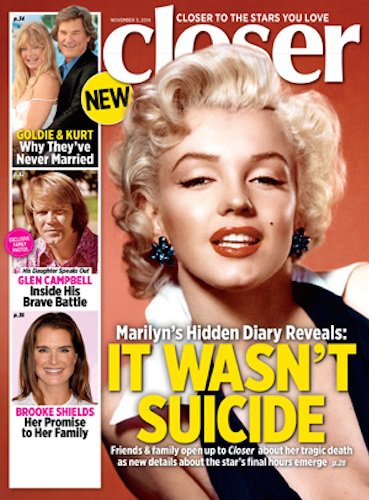
Marilyn graces the cover of US magazine Closer for the second time this year (the first came out back in June), with an article focusing on the mystery of her death. UK readers please note, the eponymous British magazine does not feature the same content. If you want to purchase this issue, try Ebay.
“Only in the new issue of Closer Weekly, Marilyn Monroe’s friends and family insist that Marilyn did not take her own life, while a new book, Marilyn Monroe: Day by Day, reveals new details from the star’s diary and the days leading up to her death.
Marilyn had made plans for ‘the day after she died…She was going to see the producers,’ Marilyn’s niece Mona Rae Miracle tells Closer. ‘It was very clear the studio was going to rehire her,’ notes Carl Rollyson, author of Marilyn Monroe: Day by Day, a new book that reveals the most comprehensive account of her last days through a paper trail of hidden diaries and appointment books. ‘She was making plans for the future.'”
More details here:
Still, 50 years after her death, many believe it wasn’t suicide at all, but a tragic accident caused by the actress taking too many sleeping pills. ‘If Marilyn had a sleeping pill at her side, she would always take it,’ Jimmie Morrissey, Marilyn’s hairdresser, reveals to Closer. ‘She was always taking pills. And she was always drinking champagne.’
But the self-medicating couldn’t completely take away her pain. ‘She was in a bad place mentally for a while,’ Sherrill Snyder, the daughter of Marilyn’s longtime photographer and close friend Allan ‘Whitey’ Snyder, tells Closer. ‘People were giving her pills because they needed her to perform,’ she says. ‘Unfortunately, Marilyn was surrounded by people who were less than vigilant’ about tracking her medication. ‘One thing led to another, but my father never believed it was suicide.'”
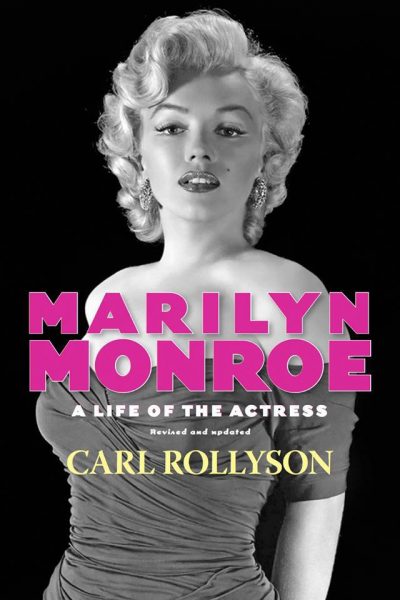
Marilyn Monroe: A Life of the Actress, Revised and Updated, the upcoming new edition of Carl Rollyson‘s 1986 biography, now has a book trailer. You can see it here.
Rollyson has also spoken about the process of writing about Marilyn in an interview with the How Did You Write That? blog.
“HDYWT: How did you come up with the idea for Marilyn Monroe: A Life of the Actress?
Carl: While Norman Mailer’s biography of Monroe has been much maligned, it is, in fact, an important work not only about Monroe but about the genre of biography …Mailer used one word to describe Monroe that no other biographer had used. He called her ambition ‘Napoleonic.’ That was very astute. The more I read about her, the more I could see his point. She really did want to conquer the world and, in many ways, she has succeeded…I spent the summer of 1980 reading the literature about Monroe. I realized that even the most important books about her, including Mailer’s, missed the most important part of her biography. She had this terrific desire to be an actress. Did she, in fact, become an actress, or just a star?
HDYWT: How did you get started on the project?
Carl: I was fortunate that I knew Bruce Minnix, director of the soap opera Search for Tomorrow. Bruce had told me long before I ever dreamed of writing about Monroe that he knew two of her friends. So I called on Bruce, who put me in touch with Ralph Roberts, Marilyn’s masseur and confidant, and Steffi Sidney, the daughter of Hollywood columnist Sidney Skolsky, who helped Monroe invent some of the more dramatic stories about her life. They, in turned, connected me with others, like Rupert Allan, Marilyn’s most important publicist. Just as important were my contacts with Maurice Zolotow and Fred Lawrence Guiles, two of Marilyn’s early and most important biographers. They were wonderful to me, sharing their insights, and providing me with still others to interview. Guiles let me visit him in the hospital while he was recovering from a heart attack, and later he sent me a recording of his interview with Lee Strasberg, Marilyn’s most important acting teacher.
HDYWT: How do you organize your research?
Carl: The breakthrough moment came when Susan Strasberg read part of an early draft. I had interviewed her about her memories of Monroe and Actors Studio, and we got along very well — in part, I think, because she could see I was going to write about Marilyn as an actress in a way no one else had done before. I sent her an early draft of the book, and she said: ‘When you tell the story of her life and her acting you establish your voice. But then there is also this other stuff that sounds like a treatise. Who are you trying to impress — your colleagues?’ That’s when I threw out about two thirds of the book and rewrote it as a narrative. As soon as I had my story, the organization of research fell into place.”
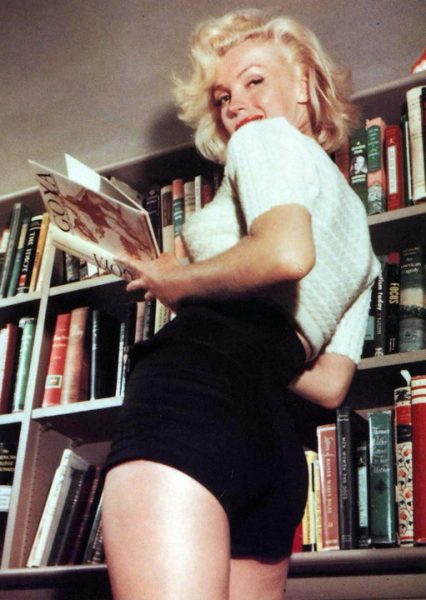
The literary world’s interest in Marilyn shows no sign of abating, with several major books due to be published in the coming months.
1) Michelle Vogel’s Marilyn Monroe: Her Films, Her Life is now available via Kindle. Print copies can be ordered from McFarland Publishing, and will soon be stocked by Amazon and other bookstores. It is ‘essentially a filmography interlaced with a complex biographical account of Marilyn Monroe’s life and loves throughout her career.’

2) Novelist Anna Godbersen is the author of the bestselling The Luxe and Bright Young Things series for teenagers. Her first adult novel, The Blonde, will be published on May 13. It reimagines Marilyn’s relationships with the Kennedy brothers, and while it’s sure to cause a stir, some may feel this work of fiction takes too many liberties with the facts. Here’s a synopsis:
“In Anna Godbersen’s imaginative novel, set at the height of the Cold War, a young, unknown Norma Jean meets a man in Los Angeles—a Soviet agent? A Russian spy?—who transforms her into Marilyn the star. And when she reaches the pinnacle of success, he comes back for his repayment. He shows her a photo of her estranged father and promises to reunite them in exchange for information: Find out something about presidential candidate John F. Kennedy that no one else knows. At first, Marilyn is bored by the prospect of, once again, using a man’s attraction to get what she needs. But when she meets the magnetic Jack Kennedy, she realizes that this isn’t going to be a simple game. What started with the earnest desire to meet her father has grave consequences for her, for the bright young Kennedy, and for the entire nation. The Blonde is a vivid tableau of American celebrity, sex, love, violence, power, and paranoia.”

3) Jay Margolis, author of MM: A Case for Murder (2011), has penned a new book on the subject with Richard Buskin, author of Blonde Heat: The Sizzling Screen Career of MM (2001.) The Murder of Marilyn Monroe: Case Closed is currently slated for release in June (US) and August (UK.)
“Implicating Bobby Kennedy in the commission of Marilyn’s murder, this is the first book to name the LAPD officers who accompanied the US Attorney General to her home, provide details about how the Kennedys used bribes to silence one of the ambulance drivers, and specify how the subsequent cover-up was aided by a noted pathologist’s outrageous lies. This blockbuster volume blows the lid off the world’s most notorious and talked-about celebrity death, and in the process exposes not only the truth about an iconic star’s tragic final hours, but also how a legendary American politician used powerful resources to protect what many still perceive as his untarnished reputation.”

4) Meanwhile, Carl Rollyson’s Marilyn Monroe: A Life of the Actress, Revised and Updated is set for US release in June, coming to the UK in August. As the first edition of Rollyson’s biography, published in 1987, was highly acclaimed and remains a fan favourite.
“Through extensive interviews with many of Monroe’s colleagues, close friends, and other biographers, and a careful rethinking of the literature written about her, Rollyson is able to describe her use of Method acting and her studies with Michael Chekhov and Lee Strasberg, head of the Actors’ Studio in New York. The author also analyzes several of Monroe’s own drawings, diary notes, and letters that have recently become available. With over thirty black and white photographs (some published for the first time), a new foreword, and a new afterword, this volume brings Rollyson’s 1986 book up to date. “
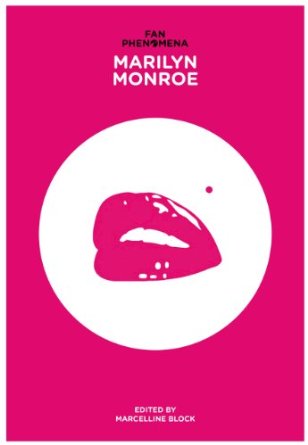
5) Fan Phenomena: Marilyn Monroe, edited by Marcelline Block, is part of a series on fandom, and is also headed for an early summer release. You may spot some familiar names in there!
” Marilyn Monroe was an actress, singer, and sex symbol whose influence far outlasted her short life. Contributors to Fan Phenomena: Marilyn Monroe situate the platinum blonde starlet’s omnipresent cultural relevance within the zeitgeist of current popular culture and explore the influence she has had on numerous elements of it…The essays here explore representations of Monroe in visual culture by looking at the ways she is reimagined in visual art while also considering how her posthumous appearance and image are appropriated in current advertisements. With an inside look at the universe of Marilyn Monroe impersonators and look-alike contests for both males and females, the book also explores numerous homages to Monroe in music…The definitive guide to one of the most famous women who ever lived, the book will be essential reading for any scholar of twentieth-century American popular culture.”
6) As I mentioned yesterday, Gary Vitacco-Robles’ Icon: The life, Times and Films of MM, Volume II (1957-1962) will also be published this summer.
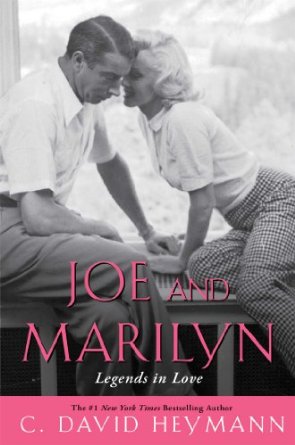
7) C. David Heymann’s Joe and Marilyn: Legends in Love was originally due to be published in 2013, but was postponed (perhaps because the author passed away in 2012.) It is now set for release in July. High hopes are riding on a definitive account of Marilyn’s most enduring relationship. However, as previously noted here, many of Heymann’s celebrity biographies have proved controversial.
According to the blurb, Joe and Marilyn is ‘based on extensive archival research and personal interviews with family and friends….Sixteen pages of striking photos accompany this unforgettable and quintessentially American story.’
8) As previously mentioned on this blog, Jacqueline Rose’s Women in Dark Times will be published in September.
“Jacqueline Rose’s heroines could not appear more different from each other: revolutionary socialist Rosa Luxemburg; German-Jewish painter Charlotte Salomon, persecuted by family tragedy and Nazism; film icon and consummate performer Marilyn Monroe.
Yet historically these women have a shared story to tell, as they blaze a trail across some of the most dramatic events of the last century – revolution, totalitarianism, the American dream. Enraged by injustice, they are each in touch with what is most painful about being human, bound together by their willingness to bring the unspeakable to light.”
9) The recent Life magazine special, The Loves of Marilyn, will be published in hardback in September. Although lavishly illustrated, the text is rather gossipy and speculative.
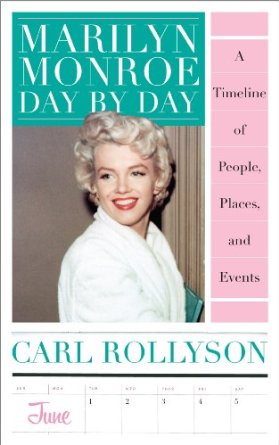
10) And finally, a second, fully illustrated book by Carl Rollyson – Marilyn Monroe Day By Day: A Timeline of Places, People and Events – is slated for US release in October, reaching the UK in December.
“Carl Rollyson provides a documentary approach to the life and legend of this singular personality. With details of her childhood, her young adult years, her ascent to superstardom, and the hour by hour moments leading to her tragic early death, this volume supplements—and, in some cases, corrects—the accounts of previous biographies. In addition to restoring what is left out in other narratives about Marilyn’s life, this book also illuminates the gaps and discrepancies that still exist in our knowledge of her. Drawing on excerpts from her diaries, journals, letters, and even checks and receipts—as well as reports of others—Rollyson recreates the day-to-day world of a woman who still fascinates us more than fifty years after her death.”
![]()
Looking forward to next year, Marilyn’s Blue Book Years: Marilyn Monroe in Unseen Pictures and Letters, by Michelle Morgan (author of MM: Private and Undisclosed) and Astrid Franse, will be published by The History Press in 2015. And Elle Andra-Warner’s American Icon: The Legacy and Death of Marilyn Monroe, originally slated for release this year, has been postponed until next spring.
“American Icon: The Legacy and Death of Marilyn Monroe is a blockbuster book that delves deep into her life and death, and separates it from the myth, rumors and Hollywood chatter. Was Monroe’s death a suicide or were dark sinister forces at work? Based on strong research, interviews, investigations, news clippings and files, American Icon takes the reader along on a unique journey that looks at Marilyn from a fresh perspective, neither sensationalizing nor sugar-coating the truth. Her life ran the gamut from happy, bored, funny, loving and loved to shocking and scandalous. She did whatever she had to do to reach her childhood dream goal to be a famous movie star. American Icon: The Legacy and Death of Marilyn Monroe delivers a fast-paced, fact-filled page turner of a book about one of the great cultural legends of the 20th century.”
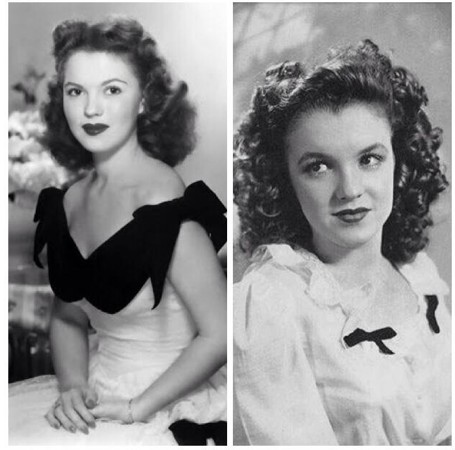
Perhaps the most celebrated child star of all time, Shirley Temple, died on Monday, February 10th. Writing for Bust, Alanna Bennett notes that in her teenage years, Shirley looked a lot like the then-unknown Norma Jeane Baker.
“I mean, look at them. It could be chocked up to 1940s/1950s styles — the hair style is certainly that, and makeup trends also probably played a part — but there’s also a definite shared heart-shaped face, lip and eye shape, nose curvature, etc.
What’s interesting to me here is that these women did not spend the majority of their lifetimes resembling each other. It appears that they did, however, sort of meet in the middle: Temple spent her young childhood as one of the most famous people in the world, then went on to live a relatively ‘normal’ life thereafter; Monroe had that relatively ‘normal’ life roughly until her breakthrough in 1948, when she was twenty-two. Temple was also born only two years after Monroe, in 1928.
Both women made a big impact on the culture of their time — generations of women spent their childhoods wanting to be Shirley Temple, and their adolescence or adulthood yearning to be Marilyn Monroe. They obviously had very complicated lives in large part because of that, but there’s something calming in seeing their similarities.”
Temple delighted Depression era filmgoers, and some have said she helped to save Twentieth Century Fox from bankruptcy during the 1930s. Marilyn would later become the same studio’s most bankable star of the 50s.
Shirley Temple Black retired from acting in 1950, aged 22, and later became a US diplomat, travelling the globe under successive Republican administrations.
Marilyn’s biographer, Carl Rollyson, speculates that ‘it was the portrayal of Shirley as waif and orphan that appealed to Marilyn and formed the basis of some of Marilyn’s stories about her childhood.’
In later life, however, Marilyn did not always welcome the comparison, as this extract from journalist W.J. Weatherby’s Conversations With Marilyn reveals:
“‘I read your article about me,’ she said. ‘Who’s Mrs Patrick Campbell?’
I had described her in the article as a cross between a theatrical grand-dame like Mrs Campbell and a child star like Shirley Temple.
She beamed when I told her, but added that she took a dim view of being even remotely compared to ‘Lolita Temple.’
‘Sorry. Now that I know you better, I wouldn’t compare you to anyone.'”
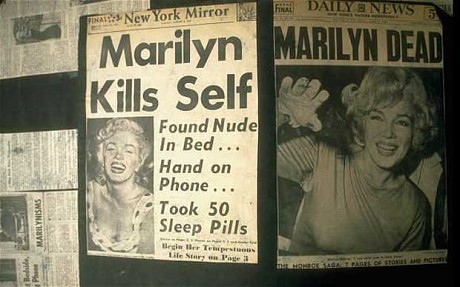
In today’s Telegraph, Gaby Wood takes a critical look at the prurient news coverage of actor Philip Seymour Hoffman‘s death from an alleged heroin overdose last weekend, comparing it to other Hollywood tragedies, including Marilyn’s:
“‘Hollywood has always been like this,’ someone said this week with a shrug, ‘look at Marilyn Monroe.’ It’s true that there have always been scandals. It’s true that the misinformation surrounding Monroe’s death was handled so shabbily, and by so many nefarious parties, that it became another form of assault. But as it happens, the case of Monroe is also instructive, and proof that things were not always this way. Because she was, at the time of her death, the product of the immediate post-studio system.
You might say she was unique: that no one could compete with her as a sex symbol; that the tragedies of her personal life made her especially vulnerable; that had she not been linked to the president the damage limitation would not have been so brutal.
But look at the year she died: 1962. The studios, who had controlled everything, and who had manufactured Marilyn out of Norma Jeane Mortenson, had collapsed at the end of the Fifties. The old orchestrators of official stories had been deposed, and a scene that would once have been carefully re-scripted became a free-for-all.
There were, instantly, lurid reports – even now, 62 years after her death, it remains one of the most raked-over episodes in Hollywood history. The time and cause of death have never been properly proven; her sheets were thought to have been changed before police arrived; autopsy photos were released; several parties claimed to have visited her bedroom and removed evidence.
Her housekeeper, psychiatrist, press agent and lovers were all implicated. And although Monroe wasn’t the first star to have been abandoned by the Hollywood system, she was certainly the biggest.”
However, as Marilyn’s biographer Carl Rollyson has pointed out, both Monroe and Hoffman deserve to be remembered for their immense talent, and not merely their untimely demise:
“I don’t think Marilyn ever did hard drugs, and I don’t think her death has much to tell us about Hoffman’s, except that as performers they were under terrific pressure to always be ‘on.’ Unlike Hoffman, Marilyn was still a contract player, even though she had her own production company, as did Burt Lancaster and others. The point about her is that she is a great transitional figure between the old Hollywood and the new. She was part of an emerging new paradigm that actually began in the late 1940s when the studios were forced by court order to divest themselves of movie theater ownership and, thanks to another lawsuit, the old studio contract that amount to indentured servitude was declared illegal. I think Marilyn’s instincts were right. If only Charlie Feldman (her agent for a while and producer of The Seven Year Itch) had pushed the studios a little harder instead of wanting to play the producer’s game, he might have helped Marilyn more. The other option was if someone had pointed out to Marilyn that she ought to go to Europe. After all, the French and the Italians were giving her awards. Maybe someone did point that out, but I don’t think it was made abundantly clear to her.”